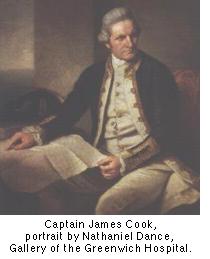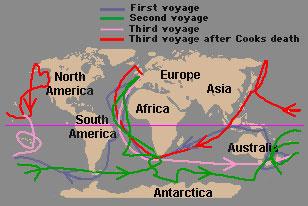James Cook
Navigator and explorer, b. 27 October 1728 (Marton-in-Cleveland, England), d. 14 February 1779 (Kealakekua Bay, Hawaii).
 James Cook was the son of a Scottish farmhand migrant who became farm foreman while James was still a child. Impressed by James' inquisitive mind, his father's employer paid for James schooling in the village school until he was 12. James then spent several years working on the land.
James Cook was the son of a Scottish farmhand migrant who became farm foreman while James was still a child. Impressed by James' inquisitive mind, his father's employer paid for James schooling in the village school until he was 12. James then spent several years working on the land.
At the age of 18 Cook became apprentice to ship owner John Walker in Whitby and became able seaman at 21, working the North Sea on Walker's 300 - 400 ton collier barks. During winter, when the ships were layed up for maintenance, he studied mathematics and navigation.
Not satisifed with the limited possibilities of advancement in the North Sea trade, Cook left Walker after 8 years to join the Royal Navy. He advanced through the ranks to master's mate and boatswain and was given the command of vessels during the Seven Yea's War of 1756 - 1763 in action in the Bay of Biscay, Nova Scotia and Quebec. After the war he spent 1763 - 1768 surveying the coast of Newfoundland.
In 1768 Cook was given the task to convey a scientific party to Tahiti for the observation of a transit of planet Vesus across the Sun. He was appointed lieutenant and given the coal-bark Endevour, a ship of only 368 tons. After the planet's transit on 3 June 1769 he was to find the southern continent ("terra australis") believed since Ptolemy to counterbalance the land masses of the northern hemisphere.
On completion of his Tahiti assignment Cook sailed west and found New Zealand. He charted all of it and continued west, to run into the east coast of Australia. He returned via Batavia (today's Jakarta) to England in 1771, where he was promoted to commander and asked to prepare a second expedition for the southern continent.
Cook's second voyage in 1772 - 1775 was one of the greatest voyages of any sailing vessel. He circumnavigated the globe in another Whitby ship, the Resolution, passing southern Africa, crossing the Indian Ocean and arriving in the Pacific. Venturing as far south as 70°S, he proved that the assumed great southern continent does not exist and that the real Terra Australis is restricted to Australia, New Zealand and whatever could lie frozen beyond 70°S. On his return he was finally promoted to captain and elected a Fellow of the Royal Society.
Cook's next assignment was a search for a navigable sea connection between the Atlantic and Pacific Oceans through the Arctic. The "northwest passage" around Canada and Alaska and the "northeast passage" around Siberia had been investigated without success from the Atlantic side, but a search from the Pacific side was believed to be more promising.
Cook set out in 1776 on the Resolution, accompanied by the Discovery, another Whitby ship. Again he rounded southern Africa, crossed the Indian Ocean and proceeded via New Zealand to Bering Strait. He verified that the Arctic connection between the two oceans is ice-covered and not navigable. Stopping briefly in Hawaii during his return voyage, Cook became involved in an argument with the local population about the stealing of a cutter and was killed on the beach of Kealakekua Bay.
Among Cook's achievements is his expert handling of diet on long sailing ship voyages. Not only did he make sure that the crews' quarters were clean and well ventilated, he also proscribed cress, sauerkraut and orange extract as part of regular meals. The only losses to his crew were from infections during port calls; not one of his men died from scurvy (a dietary disease caused by the lack of ascorbic acid that claimed many victims during long sea voyages). The health of Cook's men made his name well known in the Navy.

home
 James Cook was the son of a Scottish farmhand migrant who became farm foreman while James was still a child. Impressed by James' inquisitive mind, his father's employer paid for James schooling in the village school until he was 12. James then spent several years working on the land.
James Cook was the son of a Scottish farmhand migrant who became farm foreman while James was still a child. Impressed by James' inquisitive mind, his father's employer paid for James schooling in the village school until he was 12. James then spent several years working on the land.